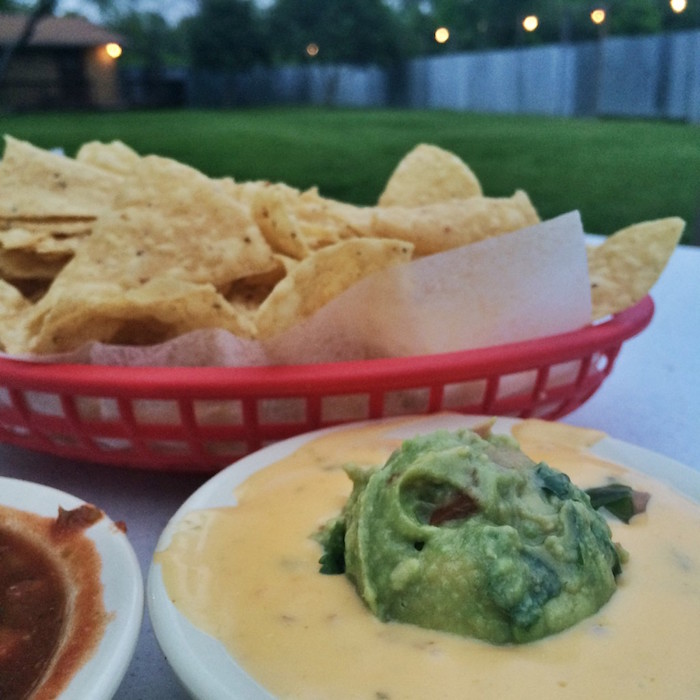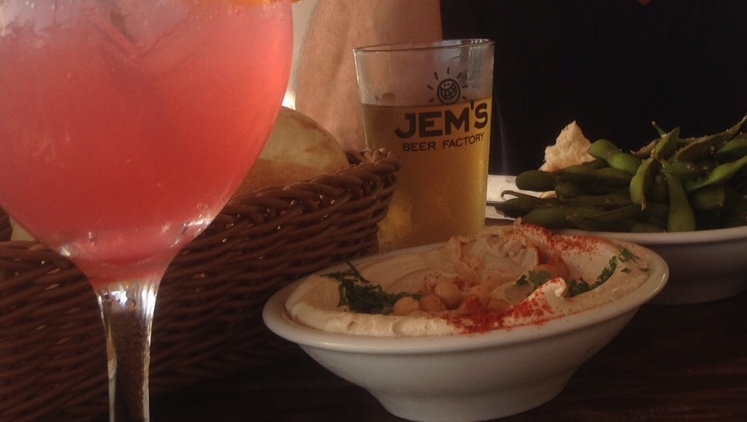
My family loves queso. We eagerly sample the cheesy dip at any possible restaurant and rate accordingly. Factors such as color, consistency, spiciness, and additional ingredients are carefully weighed. Discussions ensue, arguments arise, factions result — there’s Mexican, interior Mexican, and Tex-Mex varieties to differentiate. And then there’s the whole aspect of just how that queso is eaten: scooped up on chips or tostadas, or with corn tortillas (and do you dip or roll the queso within)?
Naturally, we make our own at home — really, is any sort of gathering complete without queso? We think not.
Hummus inspires the same passion and intense debate. The Middle Eastern and Mediterranean staple is even claimed by separate countries, Israel and Lebanon. Restaurants here in Tel Aviv have devoted entire menus solely to hummus. Everyone has an opinion on just what constitutes the best.
Basics of Hummus

It seems there are three things everyone agrees upon as essential to any decent hummus recipe: chickpeas, tahini, and garlic.
Whether canned or dried, chickpeas are the primary ingredient in hummus. These wonderful legumes (also known as garbanzo beans) are quite good for you. They provide an amazing amount of fiber and protein as well as vitamins and minerals. Take a look at what’s found in one cup of cooked chickpeas:
- 269 calories
- 45 grams carbohydrates
- 15 grams protein
- 13 grams dietary fiber
- 4 grams fat
- 0 grams cholesterol
- Vitamins and minerals, including potassium, vitamin A, calcium, vitamin C, iron, sodium, vitamin B-6, and magnesium
Tahini is a paste or sauce made out of sesame seeds. It’s very versatile and can be used in any number of ways, including as a spread, replacement for peanut butter in recipes, addition to smoothies, and flavoring for grilled items.
The amount of garlic included is pervasive but subjective. Recipes call for varying amounts, and many specify “to taste.” Garlic has many documented beneficial properties, and has been believed to a sports performance enhancer, aphrodisiac, and cancer preventative, among other claims.
Adding to Those Hummus Basics
 Beyond the Big 3 Ingredients and whether the recipe is Israeli or Lebanese (or, for that matter, anything else), ingredients vary.
Beyond the Big 3 Ingredients and whether the recipe is Israeli or Lebanese (or, for that matter, anything else), ingredients vary.
Pine nuts are usually toasted and added as a flavorful garnish.
Lemon juice, squeezed from one or two lemons, adds tartness.
Extra virgin olive oil shows up in a variety of ways: in the basic mix, drizzled on top, and as ingredient AND topper in a single recipe.
Spices, such as salt, pepper, and ground cumin, are found in varying amounts, often left to the cook’s personal discretion.
Chopped herbs (parsley, cilantro) add color and a fresh taste.
3 Recipes for Perfect Homemade Hummus
Here are three representative recipes for homemade hummus. But, as Mulder and Scully always knew in The X-Files, “The truth is out there.” You’ll have to decide just what constitutes the perfect hummus for your palate.
And then we can argue over the ultimate hummus delivery vehicle…pita bread, sliced fresh veggies, falafel chips, a sandwich, kebabs, green salad….
Recipe #1: Gluten-Free Hummus
Chickpeas are both vegan and gluten free*, and glutenfreegirl.com shared this recipe from Cooking Gluten-Free! by Karen Robertson
1 can chickpeas (reserve 1/4 cup liquid when draining)
5 tablespoons tahini
3 tablespoons olive oil
juice of 2 lemons
2–4 cloves garlic
1/2 tablespoon sea salt
Combine all ingredients in a food processor and blend until smooth.
*If you’re buying pre-made hummus, always check the label to make sure that nothing has been added that contains gluten.
Recipe #2: Israeli Hummus
The blogger at myjewishlearning.com shared this recipe from Foods of Israel Today by Joan Nathan
2 tablespoons chopped fresh parsley or cilantro
2 cloves garlic (or to taste)
2 tablespoons pine nuts
3 tablespoons extra virgin olive oil
1/2 teaspoon ground cumin
ground pepper to taste
1 teaspoon salt
1/4 cup tahini
1/2 cup lemon juice
1 cup dried chickpeas
- Soak raw chickpeas in cold water overnight.
- Drain and rinse; place chickpeas in a heavy pot and cover with cold water. Bring to boil, then simmer (partially covered) until chickpeas are soft and skin begins to separate, about 60 minutes. Add water as needed.
- Drain chickpeas, reserving 1 1/2 cups cooking liquid. Set aside 1/4 cup cooked chickpeas to be used for garnish. Process chickpeas, tahini, lemon juice, garlic, salt, pepper, cumin, and 1/2 cup liquid until a paste-like consistency. Add more liquid as necessary.
- Stirfry pine nuts in 1 tablespoon of extra virgin olive oil.
- Spread hummus on plate and make a depression in the center with the back of a spoon. Fill depression with extra virgin olive oil and sprinkle with remaining chickpeas.
Recipe #3: Lebanese Hummus
This recipe was shared by Salma Hage on her website and from her cookbook of the same name, The Lebanese Kitchen
28 ounces canned chickpeas
3 garlic cloves, peeled
4 tablespoons tahini
juice of 2 lemons
2 teaspoons sea salt
extra virgin olive oil, for drizzling
1/2 cup pine nuts, toasted
- Drain chickpeas, reserving 1/4 cup liquid, and rinse.
- Combine chickpeas, garlic, and tahini in a food processor and grind.
- Add reserved liquid, half of the lemon juice, and salt. Add more lemon juice to taste.
- Process until smooth.


